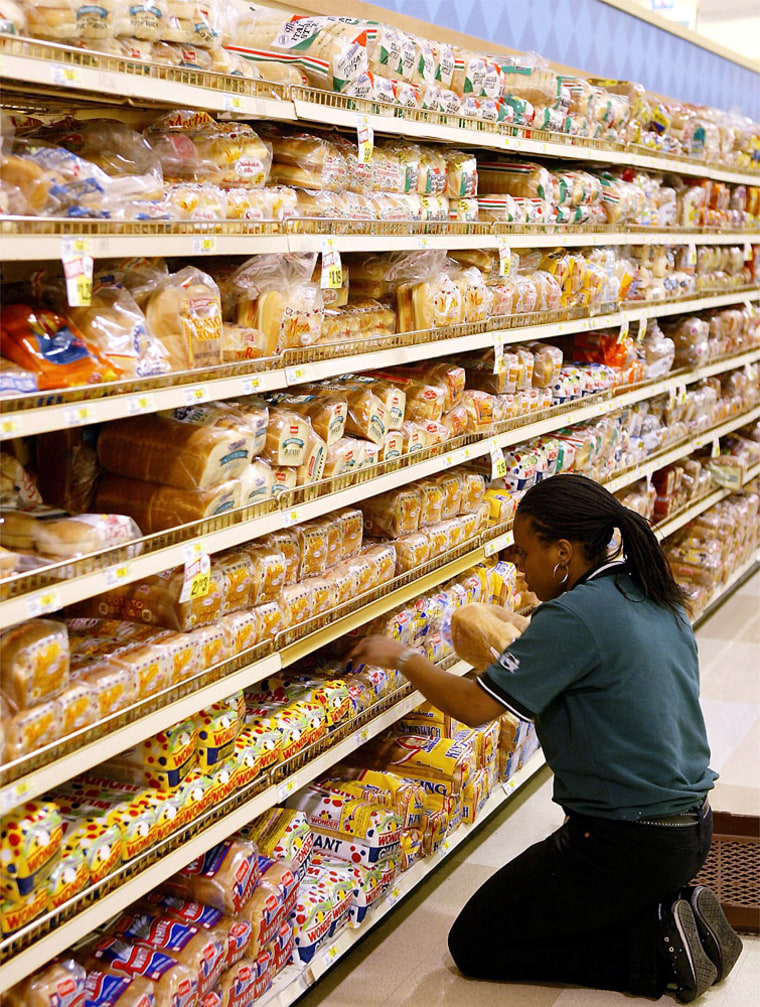Many Americans are like a loaf of bread — soft, with one side round. And some researchers believe their choice of bread may be part of the reason.
The scientists say white bread and other refined grains seem to go to the gut and hang out as belly fat.
“Waist circumference was very much associated with this high-refined grains pattern,” said Katherine Tucker, an associate professor of nutritional epidemiology at Tufts University in Boston. She and her colleagues are studying what happens to the bodies of people who eat lots of refined bread.
The scientists say white bread and other refined grains seem to go to the gut and hang out as belly fat.
Refined vs. whole grains
The researchers have been following the eating habits of a group of healthy, largely middle-aged people in Baltimore. They focused on 459 people with a variety of eating habits, including some who preferred refined grains and others who preferred fiber such as whole grains, fruits and vegetables.
For those who are not food scientists, refining removes the fibrous bran and oil-rich germ, leaving the sweeter endosperm, the whitish-colored meat of the kernel.
The Tufts researchers say that, for some reason, calories from refined grains preferred to settle at the waistline. The belt size of the white bread group expanded about one-half inch a year, which probably put some of the research subjects into a larger size of pants over the three years they were followed, Tucker said. At the end, the white bread group had three times the fiber group’s gain at the gut.
It’s not surprising that the waists of refined-grain eaters expanded, said Dr. David Ludwig, director of the obesity program at Children’s Hospital in Boston. Ludwig was not connected to the Tufts study, but his research had found something similar in a look at younger adults around the nation. One of the factors he checked was the waist-to-hip ratio — whether people’s torsos were more tapered or more round. People who ate less fiber were more round.
Heart disease risk
The size of the waistline is important for health as well as looks. A person with a bigger gut has a higher risk of heart disease than a person who weighs the same but who does not carry extra weight around the belly.
Why that is, as well as why refined grains would send more calories to the gut, is still something of a mystery. The Tufts researchers, who published the waistline data in June of 2003, are now trying to solve that mystery.
Their theory is that it’s linked to the ease in which the body breaks down carbohydrates in the endosperm into simple sugars. When sugars flood the body, insulin levels rise to help pull the sugars out of the bloodstream and store them in cells, often as fat.
“I think abdominal fat cells may be more sensitive to insulin’s effects than other fat cells in the body,” said P. Kristen Newby, lead author of the Tufts study.
Curbing carboydrates as a way to rein in the insulin response is a key rationale for popular carb-curtailing diets such as the Atkins and South Beach plans, and dieters have been giving up refined grains as a result.
Outside a Giant supermarket in Reston, Va., Pete Krone of Oak Hill, Va., said the South Beach diet took him from the farthest-out notch on his belt to the closest-in, and is pushing him toward a smaller belt. Cutting back on refined grains was a big part of it, he said.
“The South Beach diet gets rid of what’s known as the bad carbs — the high-sugar carbs, which would be white bread, potatoes, starches, pasta — and gradually replace it with wheat bread, (and) cereals that are higher fiber,” Krone said. “What went first was the fat around my waistline.”
However, while it appears that people who eat more refined grain products can wind up needing bigger belt sizes, more studies will be needed to prove it, Newby said.
This caution was echoed by Cathy Nonas, a spokeswoman for the American Dietetic Association and director of obesity and diabetes at North General Hospital in New York City. “We have to be careful about how we translate this information,” she said. “We do not have enough research.”
Meanwhile, even people who chew lots of whole grains find it hard to eschew the white stuff. ‘It is delicious,” said Robert Morehouse of California, Md., eating a sample slice of white bread outside a Great Harvest bakery in Herndon, Va, which bakes some white bread although most of its business is in whole wheat.
“I don’t normally eat white bread,” Morehouse said. “It was free.”
“Don’t you think you need white bread for a BLT?” said another whole wheat fan at the bakery, Marykate Dougherty of Arlington, Va. “There are certain things that you got to have white bread for.”
